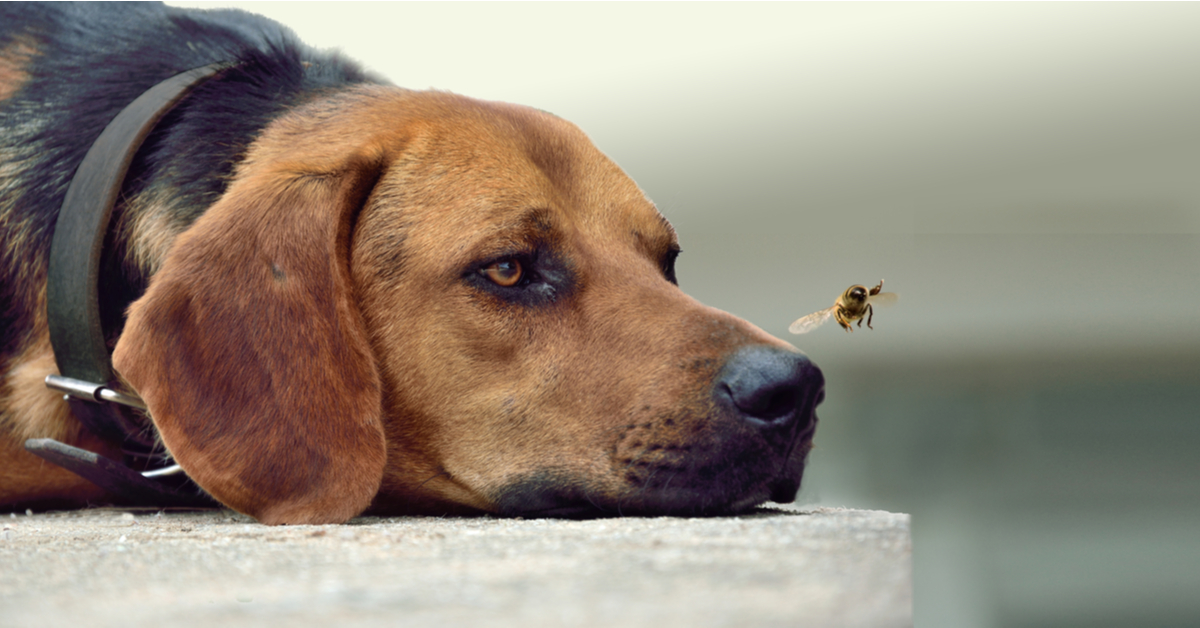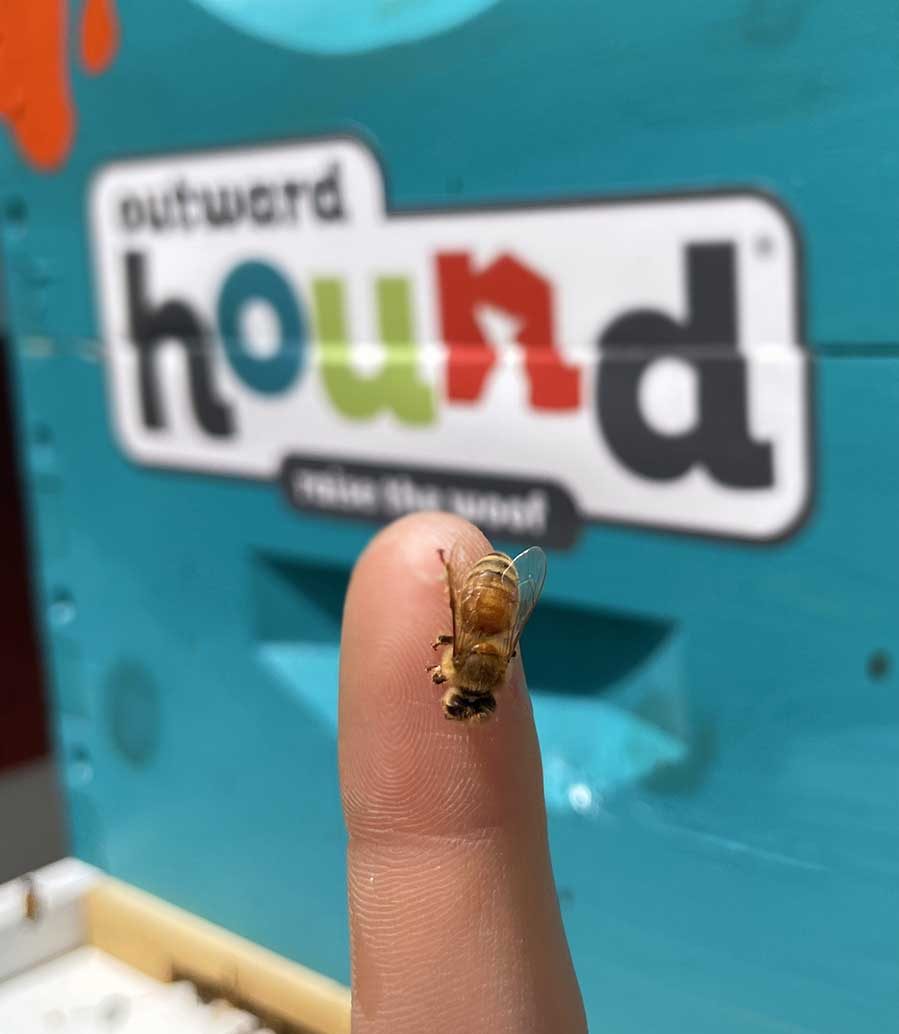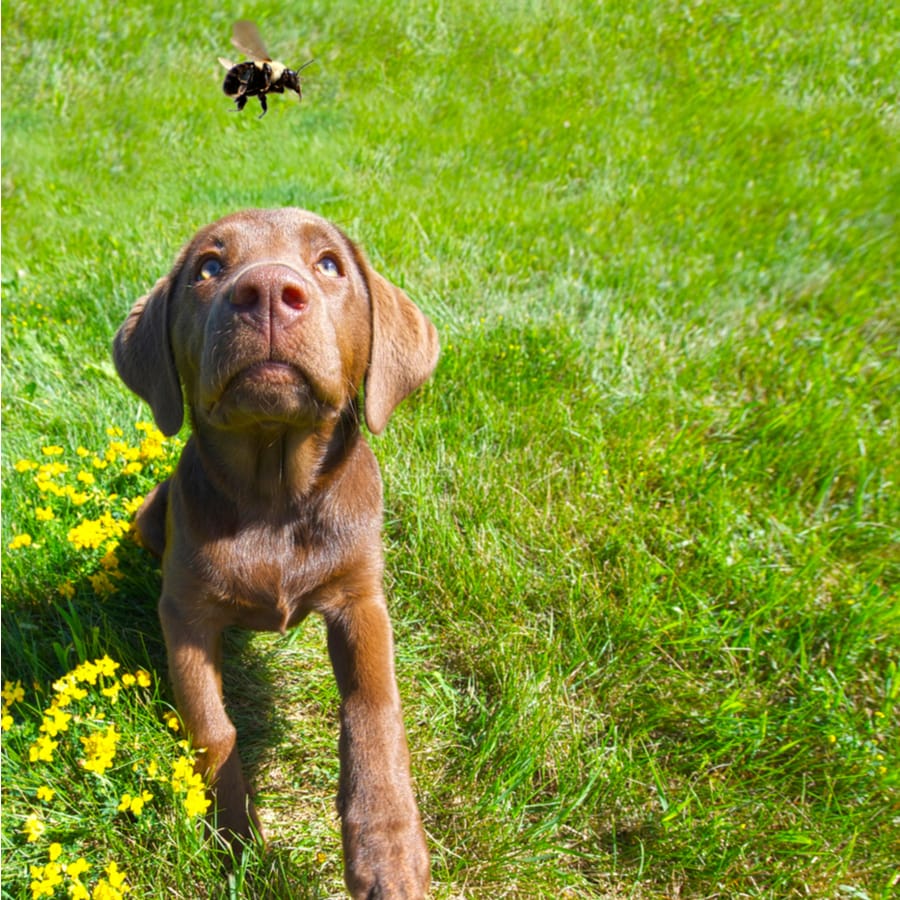Pet owners are understandably concerned about their pets coming into contact with insects like bees, which is why we asked dog mother, animal lover, and bug enthusiast Christine Webster of The Peoples Bees to put some of those worries to rest.
How likely is it that a bee or wasp will sting my pet?

It can certainly happen, but it’s not something to fear every time you go for a walk with your pup. It’s important to first understand the nature of stinging insects like bees and wasps—they’re not aggressive unless provoked. If your dog is digging holes in the backyard or at the park, it could encounter ground nesters like bumble bees and yellow jackets, which could make for a bad day.
If you notice a wasp nest forming somewhere near a high foot traffic area where you live—such as under the eaves of a roof or on a tree branch—you’ll want to keep your dog, as well as yourself and children, clear of the area until a professional can safely remove the nest for you.
The Peoples Bees offers bee and wasp removal, using non-toxic and hands-on methods as an environmentally mindful alternative to the conventional exterminator who uses poison, which may effectively kill the target, but be dangerous to you and the ecosystem in which you live. If you need bees or wasps removed from your property, please consider hiring a pesticide-free beekeeper to do this work for you.
How do I know if my pet was stung by a bee or wasp?

Being the loving, smothering pet owner you are, you’ll know when something’s not right with your furry friend. When a dog is stung by a bee or wasp, they may yip out of pain and surprise, which will demand your attention immediately. They may then begin to pace restlessly, pant despite being in a cool environment, and repeatedly lick or bite the sting location.
Here’s what to do if you suspect your dog was stung by a bee or wasp:
1. Move your dog to safety
Whether you need to retreat indoors or walk at least 20-feet away, remove your dog and yourself from where you suspect your dog was stung to prevent further agitation. If you’re able to see or photograph what you suspect stung your dog, that would be great information to have should you need to talk to your veterinarian.
2. Examine your dog
Look for sting evidence, such as swelling, tenderness, or even a stinger left behind. Should you find a stinger in your dog’s fur or skin, remove it immediately by using your fingernail or the edge of a credit card or key to pull it away from your dog.
A stinger left behind is indicative of a honey bee, whose barbed stinger usually snags on its target. Failure to remove a honey bee stinger could result in more venom pumping into your dog.
Unlike honey bees, wasps (like yellow jackets, paper wasps, and hornets) and bumble bees have smooth stingers that allow them to sting repeatedly—which is why it is so important to remove your dog from the area.
3. Clean the sting site
Once you’ve located the sting site, clean it with cold water and soap using a clean cloth, as residual venom may continue to irritate your dog’s skin or get into their mouth.
4. Contact your veterinarian
Tell them about your dog’s sting incident and ask if it’d be safe to administer an over-the-counter antihistamine. Your vet may recommend a light dose of benedryl based on your dog’s weight and health history, but it’s important you ask your vet for their approval to do so first.
5. Monitor your dog
Most dogs recover from wasp and bee stings on their own within a couple of hours, but monitoring their behavior is critical to their health during this time of uncertainty. Should their breathing become erratic or they stop drinking and eating, bring them to an emergency veterinarian clinic near you immediately.
My pet likes to chase and eat flying insects, and I’m afraid of them being stung. How do I stop this behavior?

This is a common behavior in dogs, and the best way to end it is to train them away from it. Discourage them from the behavior as soon as it happens, every time, with a firm “no” or a clicker or other sound maker to distract them.
You could also incentivize them away from the flying insect with treats. Like any pet training: consistent observation and reinforcement will help your dog to understand new boundaries.
I would like to keep a honey bee hive in my backyard, but I have a dog. Can my dog coexist with honey bees?

The answer is yes! But plan carefully and be practical, as neither the bees nor your dog should suffer at the expense of the other.
- Place hive(s) in an uninterrupted location of your property with high sunlight and low moisture.
- For the safety of your dog, use a barrier at least 4-feet from the hive entrance(s) to teach them safe boundaries around the hive(s); this may be fencing, cinder blocks, or hay bales.
- Once the hive(s) is installed, your dog may want to smell around it as the scent will be new to them. Allow them to do this, but monitor them and keep them away from the hive entrance as they may trigger the honey bees. Honey bees can be especially defensive towards animals with dark fur.
Have a Bee-quently Asked Question for The Peoples Bees? 🐝 Ask away at hello@thepeoplesbees.com.

